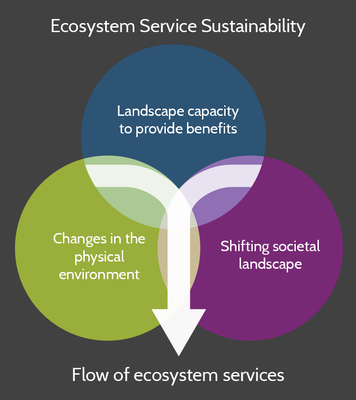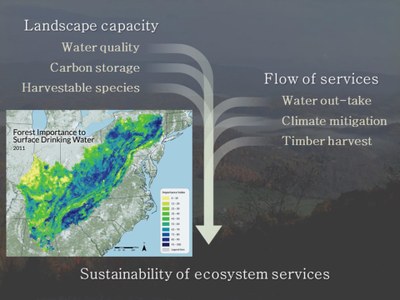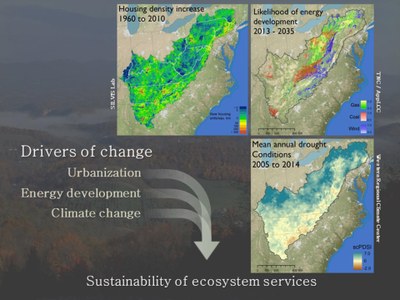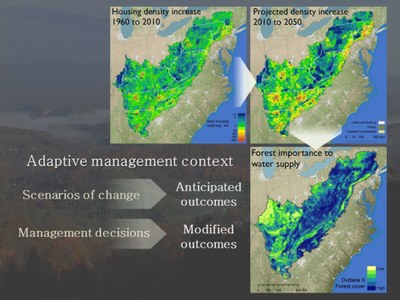An ecosystem services research framework

The region covered by the Appalachian Landscape Conservation Cooperative encompasses a rich diversity of forests, streams, and other natural resources. Millions of people benefit from ecological services provided here as diverse as clean water, forest products, outdoor recreation and tourism, fish and wildlife conservation, and the recycling and storage of carbon and nutrients. The region is also the scene of rapid environmental change—both realized and expected—which may compromise the sustainability of ecological services. The drivers behind such change broadly include changes in land use, land cover, and climate; large-scale disruptions associated with wildland fire, forest pathogens, and invasive species; and other factors acting across large landscapes.
Understanding the linkages among ecosystem services and drivers of broad-scale change within the Appalachian region is essential to effective management. Such understanding helps managers, scientists, industries, and the public establish a common language for linking the environmental and economic values of the region’s natural assets in a way that encourages protection of and investments in these resources.
Towards this goal, the Appalachian LCC is collaborating with scientists at the US Forest Service’s Eastern Forest Environmental Threat Assessment Center on new research to assess the sustainability of the region’s highly valued ecosystem services. The research team is utilizing a range of vulnerability assessment and integrative landscape resilience approaches, briefly described below.
Vulnerability assessment: a tool for understanding change
 The goal of vulnerability assessment is to measure, and map, the supply of ecosystem services provided by landscapes and the flow of those services to increasing human populations. Understanding the sustainability of these flows requires measuring key drivers of landscape change, as well as societal changes that affect the demand for services.
The goal of vulnerability assessment is to measure, and map, the supply of ecosystem services provided by landscapes and the flow of those services to increasing human populations. Understanding the sustainability of these flows requires measuring key drivers of landscape change, as well as societal changes that affect the demand for services.
By examining the change that we expect to see in these drivers, such as increasing urbanization, we can gauge possible future changes in the flow of ecosystem services. This in turn requires understanding how sensitive a service such as clean water production is to different kinds of landscape change. Vulnerability assessment uses large data sets to build models that describe these relationships.
Regional assessment: the need for data and integrative measures
 Comprehensive assessments that include the impacts of multiple risk factors are challenging, especially across a region as large and diverse as the Appalachians. It is impractical or even impossible to measure the responses of all ecosystem services to all drivers of change. Nonetheless, in the age of ‘big data’, numerous geographic data sets are available which describe past changes in the environment and the societal landscape, as well as models which describe likely future changes. Useful data products exist representing key stressors, including different aspects of land and water use and climate change models. Similarly, data products representing ecosystem services, or reliable proxies for them, are available. These may include measures of forest timber productivity, surface water yield, carbon stocks, and landscape naturalness indices, among others.
Comprehensive assessments that include the impacts of multiple risk factors are challenging, especially across a region as large and diverse as the Appalachians. It is impractical or even impossible to measure the responses of all ecosystem services to all drivers of change. Nonetheless, in the age of ‘big data’, numerous geographic data sets are available which describe past changes in the environment and the societal landscape, as well as models which describe likely future changes. Useful data products exist representing key stressors, including different aspects of land and water use and climate change models. Similarly, data products representing ecosystem services, or reliable proxies for them, are available. These may include measures of forest timber productivity, surface water yield, carbon stocks, and landscape naturalness indices, among others.
Our plan is to deliver a spatially-explicit, forward-looking assessment for a small number of key services as a first major step towards providing partners with useful new understandings of ecosystem service vulnerabilities and options for enhancing their sustainability. In addition to assessing single services one by one, more integrative measures are being developed which may provide a more holistic understanding of the capacity of landscapes to support a diversity of ecosystem services. While these measures may not provide specific information on any one resource, they may be more able to detect the resilience of ecosystems to different kinds of use. As such, they are an important complement to single-resource approaches, providing maps of broad capacities of different kinds of landscapes to support nature-based needs and values over the long term.
The resource management connection
 Ultimately, assessment efforts are only useful when they are valued by resource management and conservation stakeholders as a tool for improving sustainability. The practical goal of the assessment process is to produce tangible measures of expected change over time, which can help to weigh adaptive management options in a landscape and regional context. Vulnerability assessment can produce compelling maps and data products that describe, from a regional perspective, what the future may hold for ecosystem services under different policy and management options.
Ultimately, assessment efforts are only useful when they are valued by resource management and conservation stakeholders as a tool for improving sustainability. The practical goal of the assessment process is to produce tangible measures of expected change over time, which can help to weigh adaptive management options in a landscape and regional context. Vulnerability assessment can produce compelling maps and data products that describe, from a regional perspective, what the future may hold for ecosystem services under different policy and management options.

























